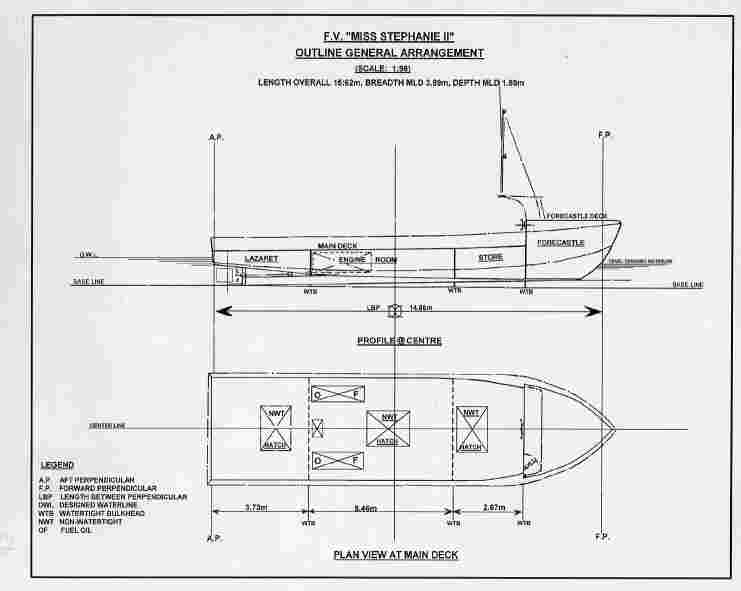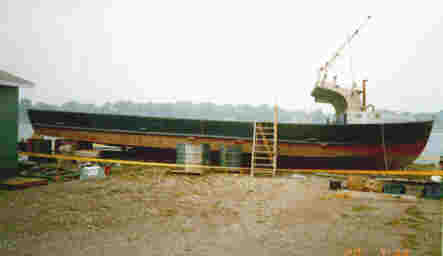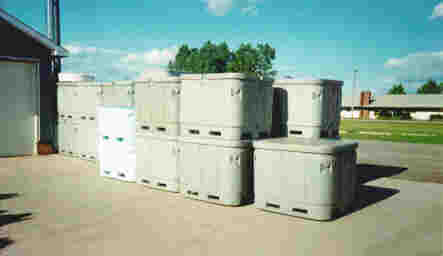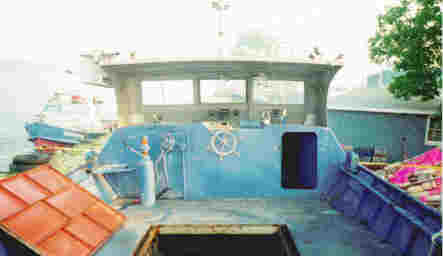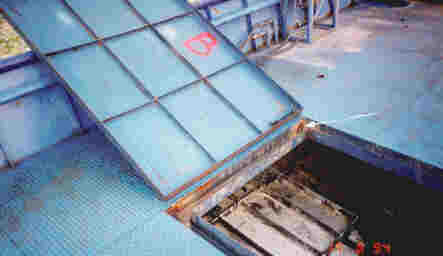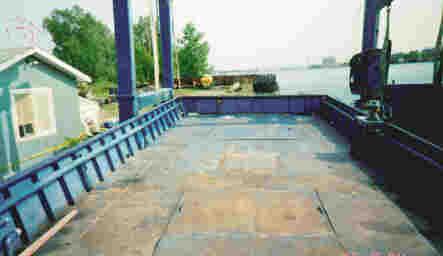Sinking - Fishing Vessel "MISS STEPHANIE II"
Lake Huron
The Transportation Safety Board of Canada (TSB) investigated this occurrence for the purpose of advancing transportation safety. It is not the function of the Board to assign fault or determine civil or criminal liability. This report is not created for use in the context of legal, disciplinary or other proceedings. See Ownership and use of content.
Table of contents
Summary
On the morning of 11 August 1994, the fishing vessel "MISS STEPHANIE II", while retrieving fish from trap nets, shipped water on her afterdeck and in the aftermost under-deck compartment. While the vessel's afterdeck was submerged, the net was let go and the vessel headed toward shore. A short time later, the "MISS STEPHANIE II" sank stern first. Two guests drowned; however, five crew members survived.
The Board determined that the "MISS STEPHANIE II" was lost following an accumulation of water in the lazaret, which could not be discharged due to an inoperative bilge pump. Subsequent progressive flooding of the engine-room led to the loss of reserve buoyancy and longitudinal stability which resulted in the sudden stern-first sinking.
1.0 Factual Information
1.1 Particulars of the Vessel
| "MISS STEPHANIE II" | |
|---|---|
| Official number | 817104 |
| Port of registry | Sarnia, Ont.Note de bas de page 1 |
| Flag | Canadian |
| Type | Small fishing vessel |
| Gross TonsNote de bas de page 2 | 15.7Note de bas de page 3 |
| Length | 15.62 m |
| Breadth | 3.89 m |
| Depth | 1.04 m (moulded) |
| Crew | 5 |
| Guests | 2 |
| Built | 1956, Toledo, Ohio, U.S.A. Rebuilt 1990, Wheatley, Ont. |
| Propulsion | One 6V-353 diesel engine, driving a single fixed- pitch propeller, capable of a speed of 10 kn |
| Owner/Operator | Purdy Fisheries Ltd. Point Edward, Ont. |
1.1.1 Description of the Vessel
The "MISS STEPHANIE II" is a small fishing vessel of welded steel construction with a sheltered navigation station which is open at its after end. The hull below the main deck is subdivided into four compartments by three transverse watertight bulkheads. The vessel's basic layout is shown in Appendix A - General Arrangement.
1.1.2 History of the Vessel
The vessel was purchased by the present owner in 1985. Since that time, the vessel has been repaired, modified and refitted extensively. On 16 June 1988, under her former name "BIG BERTHA", the vessel laid over to starboard from the ingress of water in her after compartment and sank stern first. She was subsequently salvaged. The vessel was lengthened 3.14 m in 1990, and returned to service as the "MISS STEPHANIE II" in 1994.
1.1.3 Description of the Main Deck Hatches
Details of the main deck flush-fitting hatch covers, recessed coamings and scupper drainage arrangements in way of the lazaret and engine-room are shown in Appendix B - Main Deck Recessed Hatch Coamings.
The vessel's main deck is arranged to suit two principal modes of operation: one which calls for the installation of portable fish catch storage tanks with circulated water which overflows on to the deck, and the other where the fish catch and preservation ice are stowed in insulated tote boxes loaded on the main deck. Reportedly, the recessed coamings incorporated a watertight gasket when the portable tanks were installed to ensure that the continuous overflow of catch preservation water from the storage tanks did not enter the hull, but drained overboard by way of the especially fitted under-deck scuppers.
At the time of the occurrence, the vessel was engaged in trap net fishing operations; consequently, the alternative method of stowing the fish catch in tote boxes was in use. To achieve a flush working surface in way of the catch tote boxes, the hatch coamings are recessed below the main deck level. The inboard faces of the hatch coamings are notched in way of stiffeners on the underside of the hatch covers, the stiffener occupying less than half the open area of each V-shaped notch. The flanges around the perimeter of the hatch covers do not extend to the bottom of the recesses and no watertight gaskets are fitted.
1.1.4 Description of the Fish Totes
The 1545-type fish totes are moulded-plastic, double-walled insulated containers having reinforced internal ribs and rounded corners. Each tote has a capacity of 0.68 m3. Its outside dimensions are 122 cm by 109 cm by 98 cm high, and its empty weight is 75 kg.
1.2 History of the Voyage
The crew, an Ontario Ministry of Natural Resources Fisheries Officer and two guests, a man and his two-year-old son, arrived at the boat in Grand Bend, Ontario, at approximately 0620Note de bas de page 4.
With a total of 10 totes on board, 4 of which were filled with 205 kg of ice each, and with 1,820 L (400 gallons) of diesel fuel in the tanks, the vessel had an after freeboard of approximately 200 mm to 250 mm. She left the dock at 0630 and proceeded toward the first fish net some 10.5 nautical miles (M) distant, 275° to 280° True (T) from Grand Bend, arriving there at approximately 0800.
It took about two hours to empty the net of approximately 1,360 kg of whitefish which were loaded into four totes with preservation ice and water. The vessel then proceeded to the second net about 0.25 M inshore of the first. As the second net was being emptied, the Fisheries Officer noticed the starboard stern settling low. Small wave action caused water to wash on the deck. At that time, the vessel had a total catch of about 2,270 kg of fish. A decision was made to drop the fish net, and the master headed the vessel on a southerly course toward Kettle Point, Ontario, 6 M distant.
Reportedly, the hydraulically driven service pump supplying the wash deck hose was turned off so as to maximize engine power, and 2 m of the afterdeck was awash. While proceeding, the crew moved some of the totes forward to just behind the navigation station to try to raise the stern, leaving approximately 2 m of clear deck space aft of the steering position. By about 1035, the crew and guests, except for the master, had donned lifejackets as instructed by the master and were standing under the canopy and near the navigation station.
At 1034, the fishing vessel "MARYDALE" of the same company was some 25 miles distant. Upon receiving a message from the "MISS STEPHANIE II" that she was taking on water, the "MARYDALE" apprised the Sarnia Coast Guard Radio Station (CGRS). The CGRS in turn notified Rescue Co-ordination Centre (RCC) Trenton of the situation, thus setting in motion official Search and Rescue (SAR) response.
At 1038, the "MISS STEPHANIE II" reported being in a distress situation to the Sarnia CGRS, at which time they were informed that two United States Coast Guard (USCG) helicopters, "6584" and "6590", were being dispatched from Detroit, Michigan, U.S.A.
At 1044, a Mayday relay was broadcast by the CGRS. The vessel's liferaft was taken from its stowed position on the starboard side wheel-house canopy top and placed on the main deck. The USCG base in Port Huron, Michigan, was notified and a high-speed Fast Rescue Craft (FRC) was tasked; the estimated time of arrival (ETA) on-scene was approximately 25 minutes.
At 1054, a Canadian Forces Hercules aircraft from Trenton, Ontario, was tasked. At 1102, the master indicated that the afterdeck was under water for a length of approximately 3 to 4 m. At 1111, the master informed the CGRS that the "MISS STEPHANIE II" was approximately 2.5 M from Kettle Point.
At 1126, the rescue helicopter "6584" had almost completed a circle above the "MISS STEPHANIE II" when the master radioed: "We are going down, Mayday!". By that time, the master was standing in several centimetres of water and observed a sudden drop in main engine rpm.
The vessel sank very rapidly by the stern. Two crew members managed to get clear but the others, including the two guests, had a difficult time because the buoyant fish totes became caught in the overhead of the steel navigation station canopy, blocking their exit. In the ensuing confusion, the master shed his anti-exposure worksuit which was partially on, managing to get himself free. As the vessel was being submerged, the liferaft inflated, and the crew members were able to get clear, swimming upward to the surface. Two crew members managed to board the liferaft. The two guests remained trapped. The vessel settled to the bottom in position 43°14.5'N, 081°59'W, in 15.25 m of water.
Shortly thereafter, the Ontario Provincial Police (OPP) rescue boat "JJ" arrived from Port Franks, Ontario, together with a pleasure craft and the USCG FRC. They all participated in retrieving the survivors, two from the inflated liferaft, and the remainder from the water.
When it was realized that two persons were still trapped, helicopter "6590" proceeded to Port Huron, arriving there at 1157. The helicopter picked up two divers specialized in underwater rescue and returned quickly to the scene.
At 1215, divers were deployed and, at 1218, they had retrieved the two guests who were administered CPR and transported by helicopter to waiting ambulances in Sarnia. They did not survive.
1.3 Injuries to Persons
Four crew members, including the master, and the Fisheries Officer sustained minor injuries. Unfortunately, the two guests did not survive. Autopsy determined that the cause of death was drowning.
1.4 Damage
1.4.1 Damage to the Vessel
An examination of the video taken under water by the OPP divers showed that the vessel was nearly upright, having incurred minor damage as she settled on the bottom. The forward mast was bent and a navigation station window was not in place on the port side. The electronic navigation equipment and very high frequency (VHF) radio sustained irreparable damage.
1.4.2 Environmental Damage
A light oil sheen, approximately 2,000 m long by 40 m wide, was seen initially and for several days later, until employees of the vessel's owner shut off the fuel tank vents. The vessel was salvaged on 17 August without mishap and returned to the owner's premises at Sarnia.
1.5 Certification
1.5.1 Vessel Certification
Before the sinking, the lengthened vessel was measured by the Canadian Coast Guard (CCG) and a gross registered tonnage of 15.7 was assigned. The vessel was also partially inspected, and the processing of a Steamship Inspection Certificate (SIC) appropriate to a small fishing vessel exceeding 15 gross registered tons (GRT) was started. The vessel did not fully comply with the regulations and the issue of a certificate was delayed. The owner returned the vessel to service before the SIC was issued.
Subsequent to the accident, inspection on behalf of the owner by an independent tonnage surveyor determined that the vessel was less than 15 GRT and, consequently, the regulatory requirement for a SIC was not applicable.
1.5.2 Personnel Certification and History
There is no regulatory requirement for personnel manning small fishing vessels of this size to be certificated.
1.5.2.1 Master
The master was in possession of a valid Fishing Master Class III Certificate of Competency. He had worked in his father's business for 17 years and had run boats for 13 years.
1.5.2.2 Crew
The remaining crew members consisted of permanent and occasional workers to meet the demands of the trade. They were not certificated. Normally, three persons in addition to the master were needed to make a full complement on board.
1.6 Weather Information
The weather was overcast skies, air temperature 15°C, south-west winds at 10 kn, and there was a light chop with waves of 0.5 to 0.6 m on the surface of the lake.
1.7 Stability Requirements
As a small fishing vessel of closed construction and not engaged in fishing for herring or capelin, the "MISS STEPHANIE II" was not required to comply with the intact stability requirements of Section 29 of Part 1 of the Small Fishing Vessel Inspection Regulations nor meet the criteria detailed in STAB 4 of the Stability, Subdivision & Load Line Standards (TP 7301E). Consequently, no trim and stability data were prepared for the guidance of the operator after the vessel was rebuilt and lengthened. The current deck loading practices and resultant in-service freeboards and trims have evolved through operational experience.
1.8 Bilge and General Service Pumps
Each of the four under-deck compartments is fitted with an electrically driven submersible bilge pump having a maximum rated output of 1.57 L/sec, with power supplied from 12 V service batteries located in the engine-room. Three of these bilge pumps are operated from the main deck, with on/off toggle switches at the steering position, the fourth is operated from the cabin where the electrical circuit fuses are located.
In addition to the above, a hydraulically driven pump for fire and washdown purposes was located in the engine-room. It was not in use at the time of the accident.
1.8.1 Main Deck Hatchway Scupper Arrangements
Each of the main deck recessed hatch coamings is fitted with four under-deck scuppers; however, only the under-deck scupper pipes in the lazaret hatchway are fitted with non-return valves. The valves are of simple swing-check design intended to retard the inflow of seawater when the vessel is heavily loaded and trimmed by the stern.
1.9 Post-casualty Examination upon Salvage
In view of the survivors' accounts of the stern-first sinking, post-salvage inspections focused on the following:
- identification of any structural or fittings failure in way of the lazaret and engine-room compartments;
- bilge pumping arrangements; and
- watertight integrity of main deck hatch covers.
1.9.1 Hull Structure and Fittings
Observations made during salvage and subsequent examination of the vessel revealed, among other things, the following:
- The watertight integrity of the hull, transducer, through-hull fittings and piping systems had not been breached/compromised and no source of ingress of water due to damage was found.
- A hole approximately 8 mm in diameter was found in the main deck plating in way of a starboard side air pipe, some 950 mm forward of the transom, which, in the event of water being shipped on the main deck, would allow water to enter the lazaret.
- The hatch covers, recessed coamings and under-deck scuppers of all the main deck hatchways were intact and undamaged. Although the hatch covers were in place, they were not fitted with any watertight gaskets or means of securing.
- The rudder trunk and rudder stock watertight gland in the lazaret were intact and leak- free.
- The main sea-suction box and related piping connections to service pumps were intact and leak-free.
- The inboard gland of the propeller shaft stern tube in the engine-room was intact and had a "dribble" leak that was only slightly more than that to be expected from normal operation.
- A large service battery was found firmly lodged against the port side of the propeller shaft stern-tube gland, having been displaced some 2.25 m from its original stowed position to starboard abreast the main engine, most likely on bottom contact when the vessel sank.
1.9.2 Bilge Pumps/Scuppers
The bilge pumping and under-deck scupper arrangements were inspected and tested, and the following was observed:
- Only the engine-room bilge pump toggle switch was in the "on" position. Such a configuration is consistent with the reported pumping activities shortly before the sinking when the engine-room bilges were sighted and reported to be virtually dry.
- The lazaret pump electrical wiring circuit fuse, located in the forecastle, was broken. The pump was inoperable. The tubular glass shell was broken and one of the end contact caps and the fusible link was missing. Extensive oxidization was found on the fuse holder spring clamps which indicates that this damage occurred some time before the sinking.
- An auxiliary electrical supply was jury-rigged and the lazaret submersible bilge pump tested by immersing it in a drum of water. The pump functioned properly; however, two 5 mm-diameter holes were found in the flexible concertina-type plastic discharge hose, below and inboard of the ship-side discharge. They reduced the effective discharge rate throughout the test and caused a significant proportion of the pump's output to be recirculated in the lazaret.
- Examination of the holes and weak spots in the plastic hose showed that they were most likely due to a long period of chafing or flexing. There was no indication that the hose was compressed by impact(s).
- The repeated immersion of the ship-side discharge by vessel and wave motions while the pump was inoperative would result in the accumulation of flood water in the lazaret and cause the vessel to gradually settle and trim more by the stern.
- The under-deck scuppers from the lazaret hatchway were tested: their outboard ends were partially closed off with cotton rags, and water from a garden hose was used to partially fill the pipes while still spilling past the temporary outboard obstruction. The low pressure so generated would be similar to that met in service when the vessel was trimmed by the stern and the scuppers were intermittently immersed. The hose water was found to flow freely inboard past the check valves and into the recessed coaming trough below main deck level. The water then entered the lazaret by way of the hatch cover stiffener notches in the inboard face of the coaming. This undetected (and unpumpable) accumulation of flood water in the lazaret would cause the loaded vessel to settle, trim more by the stern, and more readily ship water on the after end of the main deck.
- The absence of any pumping, once downflooding of shipped water by way of the main deck non-watertight lazaret hatch covers had started, would lead to progressive flooding and the stern-first sinking sequence reported by the survivors. It is most likely that the effects of any downflooding previously experienced on past trap net fishing trips because of low after freeboard when taking catch on board, had not then become excessive because of the timely operation of the then serviceable pump in the lazaret.
1.10 Life-saving Equipment
The life-saving equipment included two lifebuoys stowed forward, adult lifejackets sufficient for the number of people on board, an anti-exposure worksuit and an inflatable liferaft. There was no child's lifejacket on board, therefore, the child was fitted with an adult lifejacket. At the time of the emergency, all on board wore a lifejacket, except the master who was partially clad in an anti-exposure worksuit.
2.0 Analysis
2.1 Introduction
Once the vessel was salvaged, a thorough examination was conducted to determine her seaworthiness, watertight integrity and stability under various deck loading conditions.
2.2 Factors Contributing to the Ingress of Water
The ineffectiveness of the under-deck scupper pipe valves and the lack of gaskets around the perimeter of the main deck hatch coamings, in conjunction with the low freeboard and after trim, are considered to have been the principal factors contributing to the ingress of water.
Because the main deck plating in way of the lazaret was holed, any water shipped and/or accumulated on the deck would have found its way into the lazaret.
Furthermore, the repeated immersion of the ship-side discharge by wave motions while the pump was inoperative would have permitted seawater to enter the lazaret by way of the two holes in the flexible discharge hose, and caused the vessel's after trim to increase.
2.3 Flooding/Sinking Sequence
As the fish catch was brought on board from the moored trap nets, the vessel's freeboard was gradually reduced and her after trim increased. Because the trap nets were attached to the vessel's side, her normal buoyant response to the sea motions was restricted. Consequently, for about two and a half hours, while the vessel was tied up at one trap net and then the other, the prevailing waves of 300 to 450 mm regularly submerged the lazaret under-deck scupper pipes, and intermittently immersed the main deck and transom freeing ports, the lazaret bilge pump discharge and the small hole in the main deck plating.
While the vessel remained stationary, the low static pressure head generated by such slight immersion was insufficient to firmly close the swing check valves in the lazaret hatch coaming under-deck scuppers. Consequently, the shipped water regularly bypassed the valves and flowed inboard, where the absence of a watertight gasket in the recessed hatch coaming allowed such water to enter and accumulate in the lazaret. The situation became steadily worse as the flooding continued.
The marked after trim and the extent of main deck immersion observed shortly before the vessel sank are confirmed by post-casualty calculations which clearly show the vessel to have been in a highly vulnerable condition. When the lazaret was nearly half-flooded and some 3.5 m of the aftermost main deck immersed, about 30 per cent of the intact waterplane area was lost. Consequently, the centre of flotation of the remaining intact waterplane shifted forward of midships, causing a drastic reduction in longitudinal stability such that relatively small increases in trimming moment would have caused the marked after trims reported by the survivors.
As speed was reduced and the vessel finally stopped, the venturi suction effect of the cowlings at the outboard ends of all the under-deck scuppers and the main deck freeing ports was lost. Consequently, as the flooding continued, the non-watertight boundaries of the lazaret hatch became more deeply immersed causing downflooding from the main deck. Subsequent immersion of the engine-room hatch accelerated the rate of downflooding, causing the after trim to suddenly increase and the vessel to lose reserve buoyancy and sink quickly by the stern.
As the vessel was settling in the water, the totes retained some buoyancy and remained afloat, such that those nearest the navigation station became trapped under the overhanging steering canopy top as the vessel sank stern first.
2.4 Fish Totes - Hazard Associated with Stern-first Sinking
Although the totes weighed approximately 550 kg when loaded with fish/ice/water, they still retained some buoyancy. All the persons on board the vessel were positioned forward of the totes and became trapped/pinned by the totes; only some managed to free themselves. This would indicate that the hazard posed by the fish totes when the vessel is involved in a stern-fist sinking was not fully appreciated.
2.5 Stability, Freeboard and Trim Analysis
Post-casualty analysis of the vessel's stability before and at the time of the sinking is based on hydrostatic data generated from hull measurements taken from the salvaged vessel at the owner's premises, and lightship characteristics derived from an inclining experiment subsequently carried out at a nearby marina.
At the time of the occurrence, the "MISS STEPHANIE II" was outfitted for trap net fishing operations and was fully fuelled with approximately 400 gallons of diesel oil on departure. Reportedly, 10 insulated fish tote boxes, 4 of which were filled with flaked ice for catch preservation, together with 20 fish sorting trays, were loaded on the main deck. The totes were unsecured and symmetrically located about the vessel's centre line, with the aftermost arranged approximately 800 mm forward of the transom.
The trim and stability analysis focuses on the progressive increase in after trim and the related freeboard reduction during the loading of the fish catch, and addresses the most likely flooding sequence consistent with the findings of the post-casualty hull inspections and survivors' reports of the sinking.
Because the vessel had no draught marks, departure draughts were not recorded; however, post-casualty calculations based on the reported loading details show that, after due allowance for the designed rake of keel, she was trimmed 225 mm by the stern. Furthermore, the calculated freeboard of 200 mm at the transom is consistent with that observed by the crew shortly before sailing from Grand Bend.
Calculations also show that, when the initial 1,363.6 kg of catch was loaded and stowed with some flaked ice and water in tote boxes, the after trim increased to 320 mm and the main deck freeboard at the transom was reduced to 95 mm. Concurrently, the aftermost hatch coaming under-deck scupper pipe discharge and the lazaret bilge pump discharge were respectively 40 mm and 115 mm above water which, in the prevailing sea conditions, made both vulnerable to shipping water and initiating the flooding.
Calculations show that, when an additional 909 kg of fish was loaded at the second trap net, the freeboard at the transom was reduced to about 50 mm, the aftermost under-deck scupper discharges were at the trimmed waterline, and the bilge pump discharge only 75 mm above water, conditions in which the shipping and retention of water on deck and the accumulation of flood water in the lazaret would undoubtedly occur.
A further series of loading conditions with 25 per cent, 50 per cent, 75 per cent and 100 per cent flooding in the lazaret show that, while the after trim increased and the after end of the main deck was progressively submerged, the vessel still retained initial transverse and longitudinal stability, and would have remained afloat, but only in ideal static sea conditions.
When the lazaret was approximately half-filled, its non-watertight hatchway became submerged and the resultant sudden onset of downflooding accelerated the rate at which the vessel settled and trimmed by the stern. As the flooding continued, the under-deck scupper discharges in the engine-room recessed hatch coamings also became immersed which, due to the vessel's motion and the prevailing seas, resulted in the progressive flooding and sudden downflooding through the non-watertight hatch, culminating in the loss of reserve buoyancy and stern-first sinking reported by the survivors.
3.0 Findings
- Pre-sailing testing of the after lazaret bilge pump would have shown that it was inoperative due to a broken fuse.
- The non-return valves in the lazaret hatch coaming under-deck scuppers did not prevent the entry of water when only slightly submerged.
- None of the main deck hatch coamings were fitted with watertight gaskets.
- The watertight integrity of the shell plating, rudder trunk, propeller shaft stern-tube gland and other through-hull fittings was intact.
- The loaded vessel's after trim, freeboard and sea motions were such that water initially entered and accumulated in the lazaret by way of intermittently immersed apertures in the afterdeck plating, bilge pump discharge pipe and the hatch coaming which was not fitted with watertight gaskets.
- The principal lazaret flooding was due to the repeated and prolonged immersion of the under-deck scuppers and hatch coaming which was not fitted with watertight gaskets.
- The stern-first sinking was due to the loss of reserve buoyancy and longitudinal stability caused by the sudden progressive flooding of the engine-room, by way of the under- deck scuppers and hatch coaming not fitted with watertight gaskets, when the vessel stopped.
- The master was not aware of the extent of the stern trim and water shipped on the afterdeck until informed by the Fisheries Officer.
- The rate of flooding in the engine-room and on to the main deck suddenly increased when the vessel's speed was reduced and the venturi suction effect at the outboard ends of the under-deck scuppers and main deck freeing ports was lost.
- The danger posed by the fish totes as the vessel sank stern first was not fully appreciated by the vessel's personnel.
- The child was fitted with an adult lifejacket because there was no child's lifejacket on board.
- The two guests were trapped because their escape was obstructed by buoyant fish totes which became caught under the steering position canopy as the vessel sank.
- The two guests drowned before rescue could be effected.
3.1 Causes and contributing factors
The "MISS STEPHANIE II" was lost following an accumulation of water in the lazaret, which could not be discharged due to an inoperative bilge pump. Subsequent progressive flooding of the engine-room led to the loss of reserve buoyancy and longitudinal stability which resulted in the sudden stern-first sinking.
4.0 Safety Action
4.1 Safety Action Taken
4.1.1 Watertight Integrity
In November 1994, a Marine Safety Advisory (MSA) was forwarded to the Canadian Coast Guard (CCG). It apprised the CCG of the shortcomings in the seaworthiness and serviceability of the "MISS STEPHANIE II". Since there are five other vessels of similar design and configuration operated in the area by the same owner, the MSA emphasized the need for evaluating the adequacy of the fittings and configuration of these vessels with a view to improving their watertight integrity.
In response, the CCG removed the "MISS STEPHANIE II" and three other vessels from service for necessary modification. The fifth and sixth vessels have been fitted with sealed and secure hatch covers of improved design. All vessels of similar design will be modified to the satisfaction of the CCG before they can be returned to service.
This report concludes the Transportation Safety Board's investigation into this occurrence. Consequently, the Board, consisting of Chairperson, John W. Stants, and members Zita Brunet and Hugh MacNeil, authorized the release of this report on .
Appendices
Appendix A - General Arrangement
Appendix B - Main Deck Recessed Hatch Coamings
Appendix C - Photographs
Appendix D - Glossary
- C
- Celsius
- CCG
- Canadian Coast Guard
- CGRS
- Coast Guard Radio Station
- cm
- centimetre(s)
- CPR
- cardiopulmonary resuscitation
- EDT
- eastern daylight time
- ETA
- estimated time of arrival
- FRC
- Fast Rescue Craft
- GRT
- gross registered ton(s)
- IMO
- International Maritime Organization
- kg
- kilogram(s)
- kn
- knot(s): nautical mile(s) per hour
- L
- litre(s)
- L/sec
- litre(s) per second
- M
- nautical mile(s)
- m
- metre(s)
- m3
- cubic metre(s)
- mm
- millimetre(s)
- MSA
- Marine Safety Advisory
- N
- north
- Ont.
- Ontario
- OPP
- Ontario Provincial Police
- RCC
- Rescue Co-ordination Centre
- rpm
- revolution(s) per minute
- SAR
- Search and Rescue
- SI
- International System (of units)
- SIC
- Steamship Inspection Certificate
- T
- True (degrees)
- TSB
- Transportation Safety Board of Canada
- U.S.A.
- United States of America
- USCG
- United States Coast Guard
- UTC
- Coordinated Universal Time
- V
- volt(s)
- VHF
- very high frequency
- W
- west
- °
- degree(s)
- ′
- minute(s)
